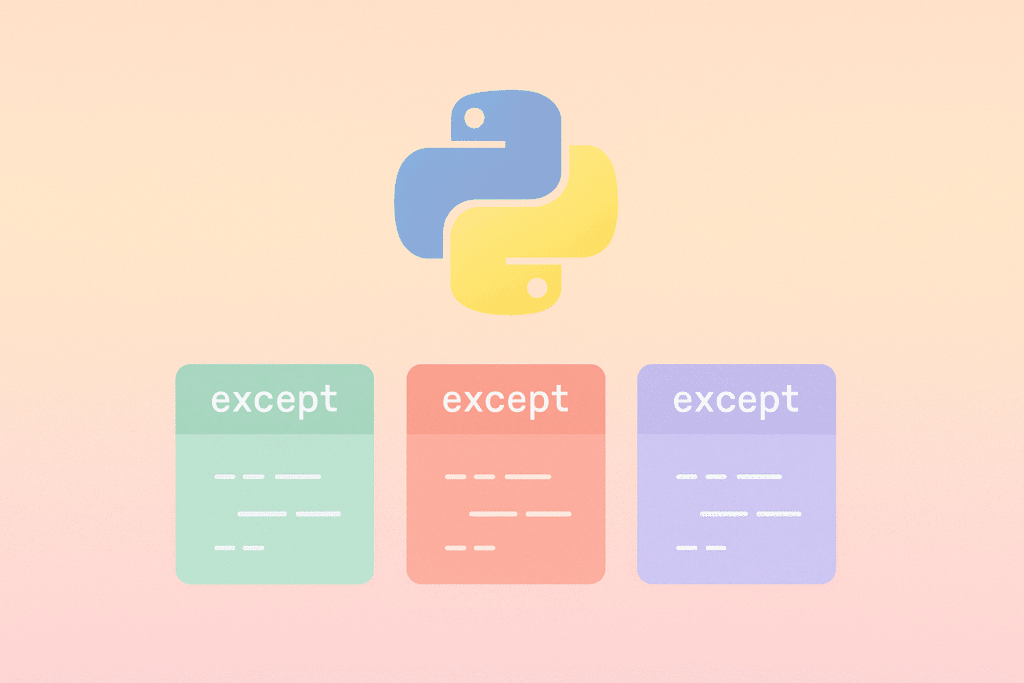Python Multiple Except Blocks allow developers to handle different types of exceptions separately, improving the reliability and readability of programs. In this article, we will explore what multiple except blocks are, why they are important, and how to use them effectively in Python with real-world examples.
What Are Multiple Except Blocks in Python?
In Python, exception handling is done using the try and except blocks. Sometimes, a piece of code may raise different types of errors, such as ValueError, ZeroDivisionError, or TypeError. To handle these specific exceptions differently, Python allows you to use multiple except blocks after a single try statement.

Why Use Multiple Except Blocks?
- Better Error Handling: You can catch specific exceptions and provide custom error messages.
- Debugging Made Easy: Different exceptions can be logged or handled uniquely for troubleshooting.
- Code Clarity: It improves code readability by separating logic for each type of error.
Basic Syntax of Multiple Except Blocks
try:
# Code that may raise different types of errors
pass
except ValueError:
# Handle ValueError
pass
except ZeroDivisionError:
# Handle division by zero
pass
except Exception as e:
# Handle all other exceptions
pass
Each except block corresponds to a specific type of exception. The last except Exception as e block acts as a fallback to catch all other exceptions not explicitly listed above.
Example 1: Handling Different Exceptions Separately
Let’s look at a practical example where multiple exceptions can occur.
try:
num1 = int(input("Enter first number: "))
num2 = int(input("Enter second number: "))
result = num1 / num2
print("Result:", result)
except ValueError:
print("Error: Please enter valid integers.")
except ZeroDivisionError:
print("Error: Division by zero is not allowed.")
except Exception as e:
print("Unexpected error:", e)
Explanation:
- If the user enters something that’s not a number,
ValueErroris raised and handled. - If the user enters zero for the second number,
ZeroDivisionErroris caught. - Any other unforeseen exception is caught by the generic
Exceptionhandler.
Example 2: Using a Tuple to Catch Multiple Exceptions
Sometimes, you may want to handle multiple exception types using a single block. Python allows grouping exceptions inside parentheses.
try:
value = int("abc") / 0
except (ValueError, ZeroDivisionError) as e:
print("Error occurred:", e)
Explanation: The code attempts to convert a non-numeric string and divide by zero. Both ValueError and ZeroDivisionError are caught by the same except block.
Example 3: Using Else and Finally with Multiple Excepts
Python’s exception handling can also include else and finally clauses for better control flow.
try:
x = int(input("Enter a number: "))
y = int(input("Enter another number: "))
result = x / y
except ZeroDivisionError:
print("You cannot divide by zero!")
except ValueError:
print("Invalid input. Please enter numbers only.")
else:
print("The result is:", result)
finally:
print("Program execution completed.")
Explanation:
- The
elseblock runs only if no exception occurs. - The
finallyblock always executes, regardless of exceptions.
Common Mistakes When Using Multiple Except Blocks
- Placing a generic
except Exceptionbefore specific ones. Always put it last. - Using too many except blocks unnecessarily — it can make code harder to read.
- Ignoring exceptions silently. Always provide meaningful messages or logs.
Best Practices
- Always catch specific exceptions first.
- Use a generic exception only when necessary.
- Log exception details using Python’s
loggingmodule for production code.
Example 4: Logging Exceptions Instead of Printing
import logging
logging.basicConfig(level=logging.ERROR, filename="errors.log")
try:
number = int("ten")
except ValueError as e:
logging.error("ValueError occurred: %s", e)
except Exception as e:
logging.error("Unexpected error: %s", e)
This code writes all errors into a log file called errors.log instead of displaying them to the user, which is a best practice for large-scale applications.
Conclusion
Using Python multiple except blocks is an essential part of writing clean and robust code. It allows developers to handle different types of errors effectively, improving user experience and code reliability. Whether you’re building small scripts or large applications, mastering multiple except blocks will make your Python programs more professional and error-resilient.

